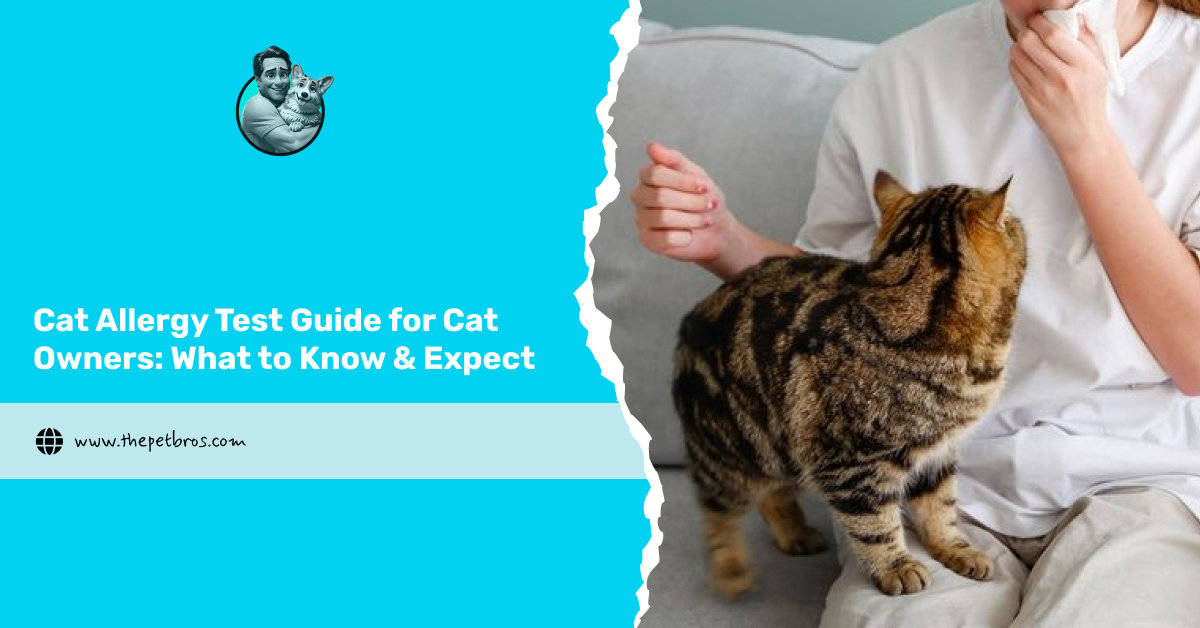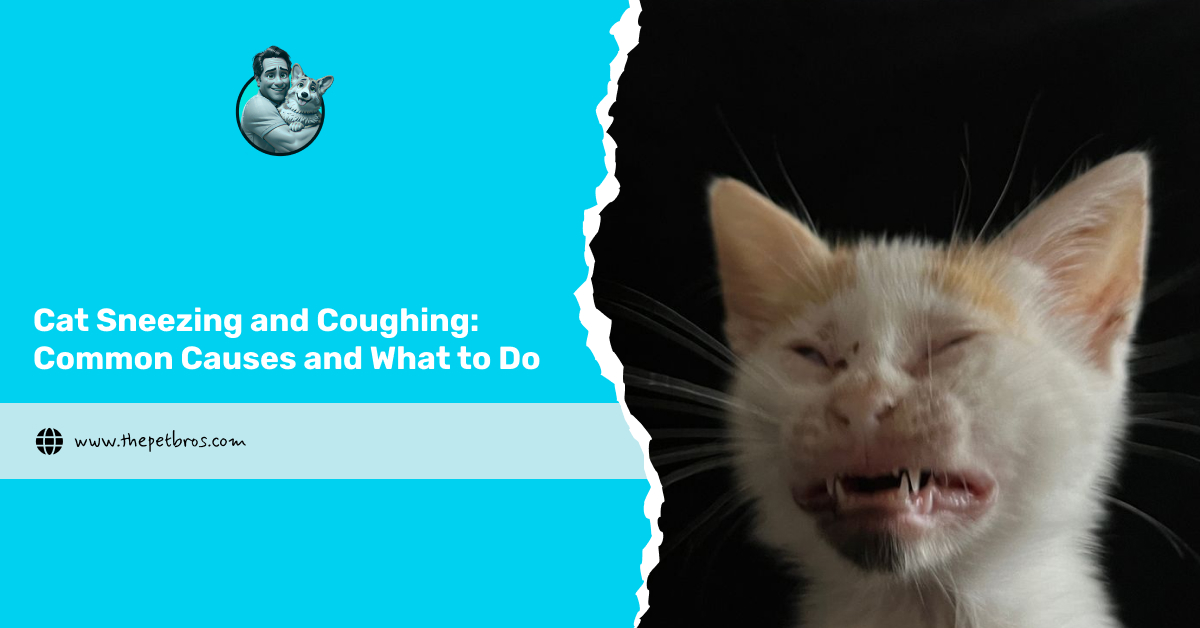Has your cat suddenly started scratching like mad or sneezing for no good reason? Maybe they’ve got a funny rash, or they keep throwing up after meals. If you’ve been left scratching your head wondering what these signs mean, it might just be an allergy. Yes, cats get allergies too, and it’ll be wise to consider a cat allergy test.
Like humans, cats can encounter allergens in their food, from some dusty rug, or even your cleaning spray. Sometimes, it could be something random triggering your cat’s immune system to go into overdrive. And when that happens, the next step might be a proper cat allergy test.
But what does a cat allergy test really mean? Is it worth doing? And how does it even work on a cat? This guide will break it all down, so you know exactly what to expect if your vet ever brings up a cat allergy test.
Types of Cat Allergy Tests
When your cat can’t stop itching, sneezing, or sporting a suspicious rash, your vet might start talking about allergy testing. Now, don’t expect some fancy one-size-fits-all solution. Allergy tests in cats are a bit more complicated than in humans, and they’re not really designed to give a neat little answer. What they can do, though, is help narrow things down so your vet can better manage your cat’s symptoms.
Let’s look at the three common routes a vet might suggest: the skin test, the blood test, and the food trial.
- Skin Test: Known as intradermal testing, this is usually done by a veterinary dermatologist. Tiny amounts of allergens are injected under the skin, and then the vet watches for any signs of a reaction, like a bump or redness. Your cat will likely be sedated so they stay calm and still, but the test isn’t painful and doesn’t take long.
It’s mainly used to check for environmental triggers like dust mites, pollen, or mould. While it’s not perfect, this method gives a more reliable picture than blood tests in most cases. But since it requires a specialist and sedation, not every cat will be a good candidate. - Blood Test: This one’s simpler. Your vet draws a small blood sample and sends it to a lab to check for antibodies against common allergens. It can be useful when skin testing isn’t practical, especially for cats who can’t be sedated or have other health issues.
While convenient, blood tests aren’t always as accurate. Results can be a bit vague, and just because a cat has antibodies doesn’t mean the allergen is actually causing problems. Still, when used alongside your cat’s symptoms, it can offer useful clues. - Food Allergies and the Food Trial: Now, if food is the suspect, forget skin or blood tests; they simply won’t help. The only reliable method here is a food trial, but be careful of the food you give them. Your vet will recommend a special diet made with ingredients your cat hasn’t eaten before, often using hydrolysed or novel proteins.
You’ll need to feed this new diet strictly for 6 to 8 weeks, without sneaky treats or table scraps. If your cat’s symptoms ease during the trial, that’s your answer. It takes patience and a bit of willpower (mostly from you), but it’s the best way to sniff out a food allergy.
What Happens After a Positive Cat Allergy Test?
So, the results are in, and your cat allergy test has flagged a few suspects. What now? First things first, your vet will go through the findings and point out which allergens might be behind your cat’s scratching, sneezing, or tummy trouble. It could be anything from dust mites to grass pollen or even something in their dinner bowl.
Once those potential troublemakers are identified, your vet will come up with a plan tailored to your cat’s needs. That might mean starting medication to calm down their symptoms, changing a few things in your home to reduce exposure, or even trying something called desensitisation. It sounds fancy, but it’s really just a slow introduction to small amounts of the allergen to help your cat build up tolerance over time.
If food is the main issue, your vet may recommend an elimination diet to figure out which ingredient is causing the fuss. It can take a bit of trial and error, but with some patience, most cats start to feel loads better. The goal is always the same: to help your furry friend get back to their happy, comfortable self.
Are There Alternatives to Cat Allergy Test?
If your cat has been scratching, sneezing, or acting generally out of sorts, you might be tempted to jump straight into a cat allergy test. But that isn’t always the first step. In fact, there are a few simpler things you can try first that might help get to the bottom of the problem.
Flea control is a big one. Even if you don’t see any creepy crawlies, fleas can still be the culprit. Some cats react strongly to just one bite, and the itching can last for ages. A good flea treatment routine, recommended by your vet, is often the first thing they’ll suggest before moving on to anything more complicated.
Then there is food. A hypoallergenic diet can work wonders, especially if there’s even a hint that your cat’s symptoms are food-related. These diets are made using ingredients that are less likely to cause a reaction, giving your cat’s system time to settle. You’ll need to feed it strictly for a few weeks, but many owners are amazed by the difference it makes.
Medication is another route. Your vet may suggest anti-itch tablets, skin creams, or other treatments to help your cat feel better while you try to pinpoint the cause. And here’s something simple but powerful: keep a little diary. Note when flare-ups happen and anything that’s changed in your cat’s environment. That way, even without a cat allergy test, you and your vet can work together to find patterns and potential triggers.
How Effective Are Allergy Tests for Cats?
A cat allergy test can sound like the magic answer when your cat is struggling with constant itching or sneezing, but it’s not always as straightforward as it seems. While these tests can be helpful tools, they do have their limits. Sometimes the results are a bit vague or unclear, which means they might point to a few possible triggers without giving a solid answer.
That’s why vets don’t rely on test results alone. The real detective work comes from looking at the full picture. Your vet will take into account your cat’s symptoms, history, and environment alongside the results of any tests. Together, this gives a clearer idea of what’s likely causing the problem and how to manage it.
It’s also worth knowing that some allergic cats can still test negative, especially if their symptoms are mild or if they are reacting to something not included in the test. This is why allergy tests work best as part of a wider investigation, rather than a one-stop solution.
So while a cat allergy test can be useful, it’s not the only piece of the puzzle. Think of it more like a helpful guide rather than a final answer. When used with other information, it can play an important part in getting your cats the relief they need, and soon enough, wagging their tails.
Conclusion
When your cat is feeling out of sorts, it’s easy to feel just as helpless. But with the right approach, a sprinkle of patience, and a cat allergy test thrown in, you’ll be well on your way to figuring things out. Whether it’s food, fleas, or something floating in the air, your cat deserves to feel their best, sleep, and even snore. Want more tips on keeping your feline happy and healthy? Stick around, we’ve got plenty more to share.
FAQs
Which allergy test is better for cats, the skin test or the blood test?
Skin tests are often more accurate, but blood tests are simpler and suitable for nervous or older cats.
Do I need to stop my cat’s medications before an allergy test?
Yes, some medications can affect results, so your vet may pause them before a cat allergy test.
Is it possible to test for food allergies in cats through blood samples?
No, food allergies cannot be confirmed with blood tests, only through a strict elimination food trial.
How much does a cat allergy test typically cost in the UK?
Prices vary widely but expect to pay between £200 and £500, depending on the clinic and test type.














